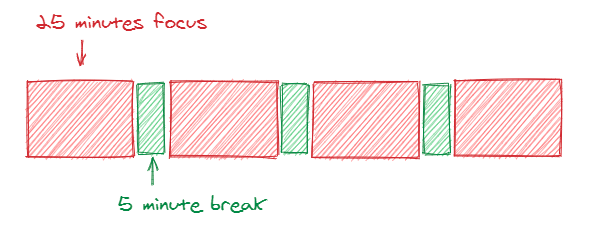🍅Productivity: Pomodoro Technique
- Published on
- • 4 min read
- Authors
- Name
- Kien
Pomodoro Technique is a time management technique that allocates 25 minutes of focus to a particular task followed by a 5 minute break (constitutes to one Pomodoro). It was developed by Franceso Cirillo in the late 1980s.

During my undergrad, I’ve struggled with focusing and studying which eventually led me to finding this technique.
I read Pomodoro Technique Illustrated by Staffan Noteberg to learn how to use this technique more efficiently and effectively and wrote a summary below for reference:
Core Fundamentals of the Technique:
Choose the highest-priority activity on the To-do Today sheet and only focus on that activity
Deming-Shewhart Cycle - PDCA (Plan Do Check Act) a problem solving process to improve processes and based on the scientific method: Hypothesis-Experiment Evaluation.
Create 3 lists: a todo today, activity inventory (holds unsorted list) and a record sheet (keeps a metric to be used for process improvements)
Do not switch or stop an activity in the middle of a Pomodoro. It takes you off your rhythm. The idea is to build rhythm to generate flow.
Dealing with distractions and interruptions
One of the main culprits that disrupt Pomodoro's are distractions and interruptions.
For distractions, my phone goes on do not disturb mode. Your phone competes for your attention, so avoiding social media notifications would be the most effective way to minimize distractions.
For interruptions, which are things we can't control, we would need to write them down in our record sheet for review and see where we can minimize them.
There are two main types of interruptions and they must be documented. We need to be able to measure our process and document events that distract us so we can identify and minimize them.
Internal Interruptions
A sudden urge to do something while in Pomodoro, completely urgent and unplanned.
Solution: Write it down on your unplanned part of your "to do today" list and document it as 1 internal interruption. The number is a measurement of how many interruptions you’ve had. Once documented, you can get this sense of urgency out of your head and focus at the task you are working on.
Body interruptions that require urgent washroom breaks. If you need to go, you must void your Pomodoro.
Solution: Shrink your Pomodoro to 15 minutes instead and eventually work your way up to 25 minutes. We need to remember that these 25 minute time blocks are precious and cannot be interrupted or we lose focus.
External Interruptions
When emails constantly go off or someone at work requires help.
Solution: Write it down so that you can remove it from your attention and get back to it later. Do not answer the e-mails right away, just finish up your Pomodoro and then reply when you are completed.
For other external interruptions, communication with your teammates might not count as an interruption as it is work related. It is up to your discretion whether to abandon your time block.
Conclusion
When doing the Pomodoro Technique, wind the timer when you feel ready and in the right mood. The Pomodoro Technique might not be for everyone, but I highly recommend it for those who need to find a way to stay productive. You might fall into two categories below which Steffan outlines in the book:
Someone who is really inspired before starting anything which might cause an overwhelming lists of tasks and might be jumping to one task after another, ultimately leading to being disorganized.
Someone who wants to really get something done in a very extensive and long session when they are in the zone. Concentration does not equal productivity and long periods of concentration will be slowed down by trivia. Pomodoro Technique allows a sustainable system with frequent breaks.
I purchased an actual day planner specific to the Pomodoro to write these tasks down. Something about going old school with pen and paper makes it feel more personal and makes me feel accountable for using a notebook.
I've spent some time on figuring out how other people use their day planner and hopefully increase my productivity.